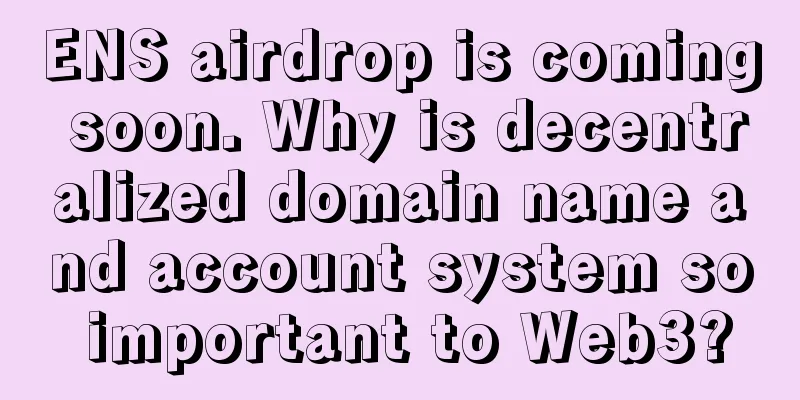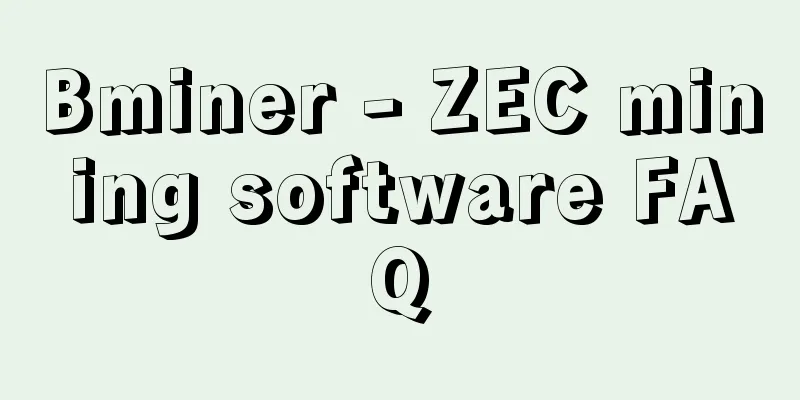ENS airdrop is coming soon. Why is decentralized domain name and account system so important to Web3?

|
Written by: Pan Zhixiong If you recall your first experience with cryptocurrency transfers, especially when confirming the recipient address, you may have been troubled by the following questions: Is this garbled address correct? Do I need to check the accuracy of each letter? Does it matter if the letters are mixed up? What if I miss a letter? Can I roll back the transaction if the transfer is wrong? In contrast, in all the conventional Internet products we use, most of the time we can safely confirm the other party's identity or address by simply confirming a simple name, user name, nickname, mobile phone number or email address. It’s as if “user experience” has never been a priority in the cryptocurrency world, and such a common demand has not been solved even after 10 years. Fortunately, more and more startup teams have begun to explore this field. Their core is to provide "translation" services, performing "lossless" translation between "computer language" and "human-readable language". This is also why when transferring money to Ethereum founder Vitalik Buterin, you don’t need to record his original Ethereum account address (0xd8dA...6045), but only need to remember "vitalik.eth", which is a typical human-readable username. In fact, blockchain networks, led by Bitcoin and Ethereum, use asymmetric encryption technology at the bottom of the account, which is often called public-private key encryption. Therefore, this system is naturally computer-friendly, which makes it quite unfriendly to human readability. To solve this problem, these teams took advantage of the smart contract function of the blockchain, or directly used the public chain itself to build a "mapping" and "translation" system to map the underlying blockchain addresses commonly used by users to human-readable "user names" as an "identity" that the user exposes to the outside world. Currently, there are several projects such as Ethereum Name Service (ENS), FIO, and DAS in the underlying protocols for building such user-readable account systems. They each have their own characteristics: ENS is the most popular, FIO provides richer functions, and DAS has better interoperability. Another scenario: Domain Name System, the business portal In addition to the account system, there is another very large application scenario, which is the "domain name system". Because the blockchain network can not only carry users' assets, but also provide various businesses or services with the support of smart contracts, especially Internet or financial businesses. Many people also call Internet services built on a decentralized technology stack Web3. Therefore, the service entrances of these businesses, that is, the "website" form commonly used in Web 2.0, may undergo some fundamental changes at the infrastructure level. In simple terms, traditional Web 2.0 applications are mainly composed of "domain names" (such as google.com) and "servers" (such as cloud services hosted on Amazon). Then, through the traditional DNS (Domain Name Service) system, the domain name and the "IP address" corresponding to the server are mapped, so that ordinary users can access Google's website through "google.com". In the world of Web3, in order to decentralize both, the storage and computing power provided by the "server" can be achieved through a combination of various decentralized technologies such as IPFS, Ethereum, Dfinity, etc., and the community also hopes to decentralize the "domain name" through the blockchain network. The earliest attempt, Namecoin, was a project that was launched more than a decade ago. It forked the Bitcoin code to create a blockchain network with top-level domain names ending in ".bit", hoping that more downstream applications would integrate them, attempting to become independent and subvert the existing DNS system. However, they also encountered their own problems. After all, the concept of the project was too advanced, so it was not until 8 years later that several similar projects appeared, such as Unstoppable Domains and Handshake. In addition, ENS and DAS also support such applications, and ENS is also the most widely used decentralized domain name. Horizontal comparison Among these decentralized domain name and account system protocols, Namecoin and ENS are the two most core ones. Namecoin is the first to use blockchain to manage domain names, while ENS has become a new account system and part of the decentralized application protocol stack with the support of Ethereum smart contracts. Together with the new protocols, all these projects can be divided into two core scenarios: focusing on domain names and focusing on account systems. Some projects also support both scenarios at the same time. The user scenarios of projects that "focus on domain names" are more about replacing or supplementing the existing DNS system. Through integration with protocols such as IPFS, the functions of fully decentralized front-end websites can be realized, so they are more focused on cooperating with web browsers (such as Brave or Opera) to improve user experience. Currently, ENS and Unstoppable Domains are the protocols most integrated by browsers. Projects that "focus on the account system" are more about giving users scenarios for using the account system, such as direct integration in decentralized applications (DApps), and more attention needs to be paid to cooperation and integration with entry-level products such as cryptocurrency wallets to improve user experience. Currently, only ENS is widely integrated in mainstream cryptocurrency wallets and DApps, and FIO claims to have received support from many cryptocurrency wallets, but the actual adoption is still in its early stages, and community attention has also declined to almost invisible. Another core difference lies in the ownership model of the registered name. Some are perpetual ownership (but may need to declare transactions once a year, just pay network transaction fees), while others are lease models, requiring annual payment of a certain lease fee. Protocols that can register permanent ownership are more user-friendly, as they are equivalent to paying once for permanent use, while the leasing model is friendlier to the protocol itself, as continuous income can be used for protocol maintenance and functional iteration. In addition, the various protocols also differ in many dimensions such as whether to choose to build their own public chain, specific registration prices, etc. The Original: Namecoin Namecoin is one of the earliest forks of Bitcoin, even earlier than Dogecoin, and its block creation time is only 2 years and 3 months later than Bitcoin. Its non-anonymous founder Vincent Durham has long retired, and the protocol has been handed over to other developers for maintenance. However, Namecoin can be considered a failed attempt. It is currently poorly maintained and has no specific applications. So if you are not interested in this history, you can skip this part and go directly to the next chapter. Therefore, many parameters of Namecoin are directly referenced from Bitcoin, with a total of 21 million native tokens NMC, but its smallest token unit "swartz" is to commemorate Aaron Swartz, the developer of the RSS protocol and Markdown protocol and co-founder of Reddit. He also previously described a solution (Nakanames) in his blog that was later implemented by Namecoin. Unlike those cryptocurrencies that use Bitcoin code to create similar ones, Namecoin hopes to use blockchain technology to store DNS-like records, that is, to record the "mapping relationship" between ".bit" and other specific IP addresses and addresses within the system on the Namecoin blockchain. So the Namecoin blockchain can also be seen as a database that maintains the record of the top-level domain name ".bit". As for why they chose the domain name ".bit", it may be because this word represents the smallest unit of binary in the computer field, "bit". Most traditional top-level domain names (such as the most popular ".com") are actually managed and maintained by a non-profit organization called ICANN, which stands for Internet Corporation for Assigned Names and Numbers. The organization was established in 1998 and is located in California, USA. In addition to managing and coordinating top-level domain names, it is also responsible for managing the allocation of global IP addresses. Namecoin is currently independent of the ICANN system. Fortunately, the ".bit" they chose is not a traditional top-level domain name, so there is still a possibility of compatibility or connection to ICANN in the future. However, compared with the centralized ICANN, Namecoin's characteristics are still very obvious. Like Bitcoin, its ledger is based on distributed storage, and its network security relies on computing power. More importantly, its domain name registration process is censorship-resistant and does not require permission. User scenario: ZeroNet In the ten years since Namecoin was born, one of the most important user scenarios came from its integration into the "decentralized network" ZeroNet, becoming a "domain name" within the network. It is also very easy to use. When users register a Namecoin domain name, they can map the page link in the ZeroNet network to a specific ".bit" domain name, and then other users can use "xxxxx.bit" to access the pages in ZeroNet. For Namecoin, it only stores the data of bit domain names and third-party system page unique identifiers (similar to IP) in the blockchain of the Namecoin network, and the third-party system only needs to run the Namecoin node to obtain all these associations. Speaking of ZeroNet itself, it is actually a relatively geeky and niche project. It uses Bitcoin's cryptography technology and BitTorrent's P2P network technology to build a decentralized network, in which users can create websites or services without permission, and the website content will also be decentralized and distributed, and can also be accessed offline. Users only need to run a ZeroNet client to access the network. The ZeroNet protocol was actively developed between 2015 and 2019, but was later neglected. The protocol has never issued tokens, and because it is too free and may be used in illegal dark web scenarios, it has been blocked by some countries through technical means. How to connect to existing infrastructure? As a protocol independent of the ICANN system, Namecoin currently has no way to directly reuse the existing Internet infrastructure, especially the domain name resolution (DNS) process. For traditional domain names, for example, when users visit a ".com" domain name, the domain name and IP address will be resolved through caches or DNS services at all levels. These are already the default processes for most devices. Users do not need to be aware of them and can just unpack and use them. However, for users of bit domain names, they still need to run specific software or services to achieve this, which will increase the user's entry threshold. The security of Namecoin blockchain data itself is guaranteed by cryptography, so users need to run a Namecoin full node first and download all domain name records to the local computer. Then they need to run an official NMControl tool, which is similar to a local DNS server and will be compatible with and handle all connections to the Internet. It may still have some compatibility issues, for example, it relies on Python, so it is not very friendly in the Windows environment. The official said, "NMControl has good compatibility, but it is not perfect." But it still has a lot of room for improvement before it can become a mass-market product. Industry benchmark: Ethereum Name Service (ENS)It is no exaggeration to say that the Ethereum Name Service (ENS) has gradually evolved into the most influential account system and decentralized domain name system in the cryptocurrency market, although it is still a small-scale project with very early user experience. ENS was originally a project incubated by the Ethereum Foundation . It was implemented based on Ethereum's smart contracts, so there was no need to maintain an additional blockchain network. Even the currency system reused ETH. It was only recently that the protocol tokens were publicly issued. Later, as the project was improved and had a continuous cash flow, it operated independently of the Ethereum Foundation. Compared with its predecessor Namecoin, ENS has further expanded its uses. It is not only limited to the field of decentralized domain names, but has indirectly become an account system with community consensus. In addition to many DeFi and DApps deploying decentralized front-end website versions through the ".eth" domain name, many KOLs in the crypto community use their ENS accounts as Twitter names, and there are also many applications that use ENS's second-level domain name as the protocol's account system. In addition, ENS’s decentralized domain name resolution capabilities have also been integrated into several cryptocurrency-friendly web browsers, such as Brave and Opera . In addition, ENS has proposed another amazing solution. Compared with Namecoin, ENS can more easily access the infrastructure of the traditional Internet and is compatible with all existing browsers . This solution is actually very simple to implement. The ENS team purchased the traditional domain name eth.link and provided resolution services for all users who access the ENS domain name. In other words, users only need to add ".link" after the ENS domain name. For example, for browsers with native parsing capabilities, visiting the "uniswap.eth" URL can enter the decentralized version of Uniswap's website, and for browsers without native parsing capabilities (such as Safari or Edge), visiting "uniswap.eth.link" can also access the website, because the holder of "eth.link" is the ENS team, and they can decide which resources their second-level domain name "uniswap.eth.link" can access. However, whether eth.link itself is accessible may vary by country or region. And this may bring some centralized risks , such as the eth.link server may be attacked. Therefore, the service provided by ENS is a solution that compromises security and user experience at this stage. In the long run, it is still necessary to rely on the full node of the Ethereum blockchain to ensure the absolute security of data. Reverse analysis: The account system has achieved initial resultsThe integration of ENS's reverse resolution function in various decentralized applications means that users and applications are viewing ENS as an underlying account system. It is necessary to explain that for Ethereum users, they usually create an Ethereum address starting with 0x as the user's payment address. Then they consider registering an ENS name, such as vitalik.eth, and mapping vitalik.eth to the Ethereum address starting with 0x. This is called forward resolution.
The reverse analysis is that when a user logs in to an application with a 0x account address, such as the Uniswap website, the user will not see the address starting with 0x, but will directly map it to the user's ENS address.
This means that users and applications have begun to use ENS names as their default usernames. What’s more interesting is that addresses that have been set up for reverse resolution will directly display the ENS account name on Etherscan, the largest block browser for Ethereum users. When the reverse resolution feature was first launched, the community was not aware of its usefulness on a large scale. However, the ENS team held relevant community events to encourage more applications and users to set up reverse resolution (because this feature requires additional steps), so it was known by various applications and users. Third-party protocol integration: the default account system for Web3 applications? In addition, ENS has also become an account system used by many protocol integrations, generally implemented through second-level domain names, such as the three major Web3 applications Mirror, Radicle, and Argent. Mirror is a decentralized content publishing platform. Text content is permanently stored in Arweave, while business logic and account systems are built on Ethereum. Since Mirror owns the traditional domain name Mirror.xyz, and ENS has carried out in-depth cooperation with the xyz domain name, the xyz domain name can also operate in the ENS system. The magic of the Mirror account system is that it has dual functions: it can be used as a mapping of Ethereum addresses and as a link to a website. Users can register (not yet fully open to the public) a mirror.xyz second-level domain name as the user's account name and URL. For example, Linda Xie's Mirror account is "linda.mirror.xyz". In ENS, this account will be resolved to an Ethereum address, and you can directly access the link in a web browser to enter Linda Xie's Mirror page. Radicle's approach is similar. It is a decentralized code management tool (similar to GitHub). In the Radicle system, users can register a second-level domain name "radicle.eth" as the username and unique identifier of the entire Radicle network. Argent is a cryptocurrency wallet based on smart contracts. Users can register a second-level domain name "argent.xyz" as their account name, making it easier for users to use wallet tools. Coincidentally, the official websites of the above three projects all end with .xyz, because ENS was more friendly to .xyz in the early days, and has now been opened to a more general domain name system. Newcomers: DAS, Unstoppable Domains, Handshake, and FIOIn addition to the two earliest domain name systems mentioned above, there are several newer protocols that are also worthy of attention, especially DAS , Unstoppable Domains , Handshake and FIO . DAS: Focus on interoperability and support any blockchainThe full name of DAS is Decentralized Account Systems. It uses Nervos as the infrastructure of the system. Precisely because of the use of Nervos, it can achieve many unique functions compared to Ethereum, such as using the private key of any public chain to register and manage DAS. In terms of specific use cases, DAS currently supports the management and control of the DAS protocol through the private keys of ETH and TRX, which means that Ethereum users can directly manage DAS-related smart contracts in the Nervos network without generating Nervos addresses. This function can be achieved because the underlying design of the Nervos protocol is more abstract and compatible with the specific cryptographic algorithms of any blockchain. For example, another team called Portal Wallet has previously demonstrated that assets in the Nervos network can be sent and received through Ethereum addresses, because Nervos can support Ethereum's public and private key algorithms. In terms of wallet support , DAS is second only to ENS. It has supported multiple mainstream wallets, including TokenPocket, imToken, HuobiWallet, AlphaWallet, HyperPay, BitKeep, etc. Applications such as NFTScan and NFTGo have already integrated DAS. In addition, DAS also uses the ".bit" domain name . After all, this domain name is not a patent of the Namecoin team, nor has it been registered by ICANN, so everyone can use it. Although it may cause some troubles to old Namecoin users, there should be no old Namecoin users (for example, I have registered a lot of Namecoin accounts, but never renewed them). In addition to being a unified cryptocurrency payment account that supports sending and receiving multi-chain assets, DAS can also be used as a homepage for personal information (bit.cc) or as a domain name for a decentralized website. However, from the team's vision and product name, DAS is more like an account system, and the domain name is just an additional function. The data growth of DAS after the launch of the main network is also worthy of attention. According to the latest official data, the number of independently registered addresses in the past three months has exceeded 5,000 , and the number of registered accounts has exceeded 25,000 . At present, only 35% of the total number of 4 digits and above is open. In the future, more registrable accounts should be gradually opened as the system matures. Unstoppable Domains: Permanent Ownership DomainsUnstoppable Domains has launched the ".crypto" (and many other) top-level domains where you can purchase permanent ownership, and Unstoppable Domains has a great advantage in browser integration, and it also supports almost all browsers supported by ENS. In addition, Unstoppable Domains has also developed its own web browser (based on the open source version of Chrome) to provide a more perfect user experience. Unstoppable Domains did not launch an independent blockchain, but is based on smart contracts of other blockchains. For example, the ".cryptp" domain name service is a smart contract system in the Ethereum network. From this perspective, it can easily draw on the ENS protocol. Handshake: Auction any top-level domainHandshake has a bigger ambition, hoping to build a system completely parallel to ICANN from the beginning of the namespace. In this system, users can register ".crypto" or ".eth", but they have to auction first, so it can provide an infinite number of possible domain name structures. In addition, in order to migrate the existing DNS system, it has also reserved some of the world's most well-known websites. The holders of these domain names can obtain domain names in Handshake as long as they pass cryptographic verification. Handshake is an independent public chain that uses the PoW mining mechanism, and a professional team has launched Handshake mining machines. However, one problem this may bring is that protocols that originally only need to handle business logic need to worry about the network's computing power and the possibility of being attacked, while ENS and Unstoppable Domains only need to rely on the security of Ethereum. FIO Protocol: Focus on Cryptocurrency Wallet IntegrationFIO Protocol is a decentralized account system that focuses on working with wallets, as its full name is Foundation for Interwallet Operability. Its most important partner is the wallet , as it is the entry-level application of cryptocurrency. Deep integration with wallets can provide a more complete user experience for the FIO Protocol. For example, for transaction functions, it can provide functions such as "request transaction" and "context transaction". FIO Protocol has also launched its own blockchain network, which uses dPoS consensus . This may become an advantage in terms of high performance, but it may also become a disadvantage in terms of security. SummarizeThe blockchain-based decentralized domain name and decentralized account system has been around for 10 years. Although the pioneer Namecoin is still running, it has become a niche project with relatively low user adoption. Later, ENS took a more pragmatic approach, and with the rapid expansion of the Ethereum ecosystem, it also gained a lot of dividends. Many third-party applications used it to build specific account systems, becoming an indispensable infrastructure for the Ethereum ecosystem. Precisely because it is so deeply bound to the Ethereum ecosystem, it may limit it from becoming a more general protocol. After all, it always feels weird to use an Ethereum domain name ".eth" to send and receive assets such as Solana, Mina, BTC, and BSC. So from this perspective, ".crypto", ".bit" or protocols with customizable top-level domain names will be more generous, and their domain names are more universal. In addition, these protocols are also exploring more possibilities from wallet integration, interoperability, and ownership models. Fortunately, the number of projects in this field is not as large as DeFi, nor is it particularly homogeneous. Whether there will be one dominant protocol or multiple protocols in the future is not important, but I believe that in the Web3 world, such a decentralized domain name and account system is definitely needed to carry applications, websites, and user identities. However, these projects are still in the very early stages of exploration, and there is still a lot of room for improvement in protocol integration, user experience, and access to the Web2 world. |
>>: Various giants enter the Metaverse
Recommend
Your hand shape reveals your personality and luck
Your hand shape reveals your personality and luck...
Is it good to have eight-character lines on the forehead? What do eight-character lines on the forehead represent?
The eight-character lines are mainly on the sides...
What does it mean when the fate line becomes longer?
There are many important lines in the palm, which...
What does it mean when eyebrows are connected together?
Eyebrows that grow together are called connected ...
Palmistry diagram: What kind of palmistry is the best?
What are the palm lines for a happy marriage? Mar...
What industry is suitable for you?
As the saying goes, there are top talents in ever...
Is it good for a man with a low nose bridge? His life is monotonous and it is difficult to have something new!
What does a man with a low nose look like? The no...
Detailed explanation of what kind of palm lines are good for girls to be born rich and lucky
It is a well-known fact that palmistry is related...
What kind of woman would be willing to return to her family?
When it comes to returning to the family, some pe...
What is it like to live in the Philippines and South Korea on Bitcoin alone?
A chart about the usability of Bitcoin for daily ...
Alipay is prohibited from being used for virtual currency transactions and the service will be suspended immediately
Sina Finance News: On October 10, the Alipay Secu...
The current effective computing power of the Filecoin network is 12.59EiB
Filfox browser data shows that the current block ...
Will wearing colored contact lenses affect your fortune? How should you wear them?
Some people choose to wear colored contact lenses...
Four characteristics of girls with pointed chins
Four characteristics of girls with pointed chins ...









